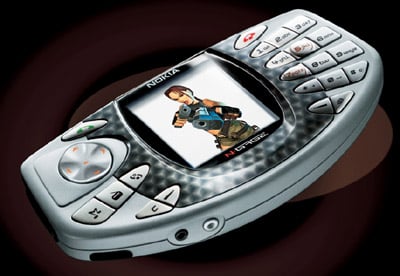This article is more than 1 year old
Nokia N-Gage
Is it phone? Is it a console? Bird? Plane? No, it's...
Reg Review The trouble with Nokia's N-Gage, say the gamers, is that it's a phone, not a console. Likewise, handset specialists bemoan what cramming mobile phone functionality into a handheld console has done to the telephony experience.
Nokia, of course, can't win. In devising a device that attempts to leverage the growing demand from games in phones by bringing the games business to the mobile world, it inevitably runs the risk of failing to please either gamers or phone users, just as the first smartphones didn't meet the needs of PDA fans or consumers who want more from their handsets.
After giving the N-Gage a whirl, it's clear some of the grumbles are justified. The device definitely exhibits a kind of schizophrenia, not knowing what kind of device it should be. For example, it requires a SIM card. As a phone, the N-Gage needs one, as a console it doesn't. Nokia is adamant that the machine is first and foremost a console, but you can't play games without one.
And yet adding a new game card requires all the manual dexterity and device deconstruction that is needed to insert a SIM card into a phone. If PDAs can offer open, buffered SD or CompactFlash slots, why can't the N-Gage?
But do the inevitable limitations imposed by hybridising two distinct device types matter as much as many game players and handset reviewers have made out? Is the N-Gage fundamentally flawed, or has Nokia got the balance right?

The N-Gage certainly looks the part. On either side of the nice but small 176 x 208 LCD are the usual Nokia-look call and hang-up buttons (at the top), and menu buttons below the screen. On the right-hand side sit the numeric/text pad. Over on the left is the joypad and, to fill a space, buttons for three apps: Music Player, Radio and the application launcher. One of these really should run whatever game card you've got inserted.
Around the side of the device is the on/off switch (right-hand side), twin headphone sockets (underneath), and USB port and power jack (left-hand side). There's a microphone in there too, and a loudspeaker.
A smartphone, not a smart phone
As a smartphone, we enjoyed using the N-Gage more than we did Sony Ericsson's new P900. Much as we liked the P900's hardware, we didn't get on so well with its UIQ user interface. We weren't keen on its look and feel, and found it slow and unresponsive to use. The N-Gage's shares the P900's Symbian OS foundation, but uses Nokia's own Series 60 UI. It's not only more aesthetically pleasing than UIQ, but felt quicker to use.
We ran Apple's iSync to transfer nearly 300 contacts to the N-Gage via Bluetooth. The software detected the device immediately, and the sync was fast and free of the 'will it work this time or not' uncertainty we experienced with the P900.
Scrolling through the list of names was reasonably quick, but jumping to a letter made tracking down the right individual even fast. Select them, and up come their details. Scroll down to phone numbers - highlighted with telephone or mobile icons - or email address, and initiating a call or sending a message is a click away.
Calendar entries are similarly easy to read, cramming in not only appointment details, but day, week and month views that are pleasant to read. There's no need to squint. On the basis of the P900's UI, we decided we couldn't move from our trusty PalmOne Tungsten to a smartphone. Having tried Series 60 on the N-Gage, we're no longer so sure.
The N-Gage lacks a stylus, so you're forced to use the numeric keypad SMS-fashion to add entries and enter information like email account details. It's not easy - though we're sure frequent txt'rs won't have any problem - but once it's done, it's done. We suspect that Nokia believes - not unreasonably - most folk with a large contacts list will either have them in the SIM, or keep them on a computer.
In phone mode, the handset displays the time, date, network and phone-relevant icons for voice messages and so on. In place of a Nokia handset's usual Menu and Names on-screen options, you can go to Contacts or Messaging - the N-Gage's unified in-box app - but these two options can easily be changed.
You can't change what the N-Gage's physical buttons do. Pressing the launcher control displays icons representing available applications, some stored in sub-folders, displayed in a grid or as a list. You can quickly select any of them using the joypad, and you can move icons up to the main listing, into other folders, or change the order in which they're displayed. Alongside the PIM apps available are RealOne Player for video, Images (photos), Composer (write your own ringtones), plus apps for all the usual Nokia phone options, such a usage profiles, Bluetooth and so on.
Nokia doesn't get everything right. We've mentioned the SIM requirement. Similarly, Music Player quits if there's no memory or game card in place, whether they have MP3 content on board or not.
Games appear as an icon in the root directory. Once selected and launched, the game stays in memory until the N-Gage is turned off. Pressing the phone keys, or one of the application buttons takes you away from the game. Relaunching it from the application launcher takes you straight back to where you were, as if you'd left it on pause. This is a boon for gamers and infinitely superior to forcing you to start the game from scratch each time.
Some titles will let you save the game state too. We recommend you do so - the N-Gage isn't beyond crashing and taking your current game data with it.
